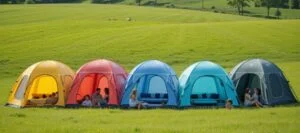When it comes to backpacking, choosing the right tent is one of the most critical decisions you’ll make. Your tent is more than just a place to sleep—it’s your shelter against the elements and a home base after a long day of hiking. With so many options available, it’s easy to feel overwhelmed. To simplify your decision, we’ve outlined five essential features to look for in a tent that’s perfect for backpacking. Let’s dive in!
1. Lightweight Design: The Key to Easy Carrying
When backpacking, every ounce matters. A heavy tent can quickly become a burden, especially on long treks or steep trails. Look for a tent that balances weight with durability.
- Single-Person or Minimalist Designs: If you’re solo backpacking, opt for a tent weighing less than 3 pounds. Ultralight tents can weigh as little as 1.5 pounds but may sacrifice some features for weight savings.
- Materials Matter: Lightweight materials like ripstop nylon or silnylon are ideal for backpacking tents. They’re durable but won’t weigh you down.
- Compact Storage: Choose a tent that packs down small enough to fit into or attach to your backpack without taking up too much space.
Quick Tip: Pay attention to the packed size dimensions as well as weight. A tent that’s lightweight but bulky can still be inconvenient.
2. Weather Resistance: Stay Dry and Protected
Your tent needs to keep you safe from whatever Mother Nature throws at you—whether that’s rain, wind, or intense sun. The level of weather protection is a non-negotiable factor for backpackers.
- Waterproofing: Check for a high hydrostatic head rating (measured in millimeters). Aim for at least 1,500mm for the rainfly and 3,000mm for the floor.
- Rainfly Coverage: A full-coverage rainfly offers superior protection against rain and wind. Look for adjustable rainflies that allow ventilation while still keeping the interior dry.
- Seam Sealing: Factory-sealed or taped seams prevent water from sneaking through the stitching during downpours.
- Wind Resistance: Dome or low-profile designs are better at withstanding high winds compared to taller cabin-style tents.
Pro Tip: For added confidence, treat your tent with a waterproof spray or seam sealer before heading out on a trip.
3. Ease of Setup: Save Time and Energy
After a long day of hiking, the last thing you want is to wrestle with a complicated tent setup. The best backpacking tents are quick and easy to pitch, even in low light or bad weather.
- Freestanding vs. Non-Freestanding: Freestanding tents can be pitched anywhere without requiring stakes, which is handy on rocky or uneven terrain.
- Color-Coded Poles and Clips: These features make the setup process intuitive, saving you time and hassle.
- Quick-Pitch Designs: Some tents, like pop-up or semi-automatic options, can be set up in under 5 minutes. While they’re convenient, make sure they don’t compromise on durability.
Why It Matters: Backpackers often set up camp just before sunset or during adverse weather. A simple design ensures you can rest quickly without added frustration.
4. Ventilation: Avoid Condensation and Stay Comfortable
Ventilation is often overlooked but incredibly important in a backpacking tent. Without proper airflow, condensation can build up overnight, leaving your gear damp and your sleep uncomfortable.
- Mesh Panels: Tents with large mesh sections provide excellent airflow while keeping bugs out. These are especially useful in hot or humid conditions.
- Vents in the Rainfly: Adjustable vents allow air circulation without compromising weather protection.
- Double-Wall Design: A tent with a separate rainfly and inner tent minimizes condensation compared to single-wall tents.
Pro Tip: Look for tents with multiple ventilation points to promote cross-breeze and reduce the risk of waking up to a wet interior.
5. Durability and Longevity: Built to Last
Your tent is an investment, and it should last for years of adventures. Durability ensures your tent can handle rough terrains, sudden weather changes, and repeated use.
- Floor Material: Opt for thicker, durable flooring with a waterproof coating to prevent tears from sharp rocks or roots. A denier rating of 40D or higher is ideal for the floor.
- Poles: Aluminum poles are strong yet lightweight, making them perfect for backpacking tents. Avoid fiberglass poles, which are more prone to breakage.
- Zippers and Stitching: Check the quality of zippers and stitching, as these are common failure points in cheaper tents.
Maintenance Tip: Always use a groundsheet or footprint to protect the tent floor and extend its lifespan.
Additional Features to Consider
While the five essentials above are the most critical, there are other features that can enhance your backpacking experience:
- Vestibules: Extra covered space outside the sleeping area for storing gear and boots.
- Interior Pockets: Keep small items like a flashlight or phone organized and within reach.
- Reflective Guy Lines: Improve visibility at night, reducing the risk of tripping.
- Multiple Doors: For two-person tents, having two doors allows easy access without disturbing your tent mate.
Top Tent Recommendations for Backpacking
Here are a few popular backpacking tents that meet the criteria above:
- Big Agnes Copper Spur HV UL2: Lightweight, weather-resistant, and packed with features for backpackers.
- MSR Hubba Hubba NX: A versatile option with excellent ventilation and durability.
- Nemo Hornet 2P: Ultralight and compact, ideal for minimalist backpackers.
Reminder: Always read reviews and test your tent before heading out to ensure it meets your specific needs.
Conclusion: Find the Perfect Balance
The best tent for backpacking is one that strikes the right balance between weight, durability, weather resistance, and comfort. While ultralight options may be appealing, don’t sacrifice essential features like waterproofing and ventilation. Remember, your tent is your refuge in the wilderness—choosing wisely ensures a safe, enjoyable, and stress-free adventure.
Reviewed and updated on 01/24/2025




